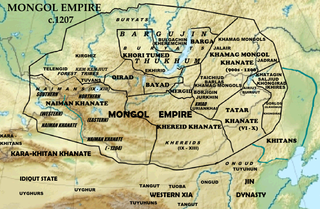Turkestan, also spelled Turkistan, is a historical region in Central Asia corresponding to the regions of Transoxiana and Xinjiang.

The Kara-Khanid Khanate, also known as the Karakhanids, Qarakhanids, Ilek Khanids or the Afrasiabids, was a Turkic khanate that ruled Central Asia in the 9th through the early 13th century. The dynastic names of Karakhanids and Ilek Khanids refer to royal titles with Kara Khagan being the most important Turkic title up till the end of the dynasty.

The Qara Khitai or Kara Khitai empire (1124–1218), also known as the Western Liao dynasty, officially the Great Liao, was a sinicized dynastic empire in Central Asia ruled by the Khitan Yelü clan, and a successor state to the Liao dynasty. The dynasty was founded by Yelü Dashi, who led the remnants of the Liao dynasty from Manchuria to Central Asia after fleeing from the Jin dynasty conquest of their homeland in northern China. The empire was usurped by the Naimans under Kuchlug in 1211; traditional Chinese, Persian, and Arab sources consider the usurpation to be the end of the dynasty, even though the empire would not fall until the Mongol conquest in 1218. The Qara Khitai is considered by historians to be a legitimate dynasty of China, as is the case for the preceding Liao dynasty.

The Anushteginid dynasty also known as the Khwarazmian dynasty was a Persianate Sunni Muslim dynasty of Turkic mamluk origin. The Anushteginid dynasty ruled the Khwarazmian Empire, consisting in large parts of present-day Central Asia, Afghanistan and Iran in the approximate period of 1077 to 1231, first as vassals of the Seljuks and the Qara Khitai, and later as independent rulers, up until the Mongol conquest of the Khwarazmian Empire in the 13th century.

Tolui (c.1191–1232) was a Mongol khan, the fourth son of Genghis Khan by his chief khatun, Börte. At his father's death in 1227, his ulus, or territorial inheritance, was the homelands in Mongolia, and he also served as civil administrator until 1229, the time it took to confirm Ögedei as second Great Khan of the Mongol Empire (1206–1368). Before that, he had served with distinction in the campaigns against the Jin dynasty, the Western Xia and the Khwarezmid Empire, where he was instrumental in the capture and massacre at Merv and Nishapur. He is a direct ancestor of most of the Ilkhanids.

The Chagatai Khanate, or Chagatai Ulus, was a Mongol and later Turkicized khanate that comprised the lands ruled by Chagatai Khan, second son of Genghis Khan and his descendants and successors. At its height in the late 13th century, the khanate extended from the Amu Darya south of the Aral Sea to the Altai Mountains in the border of modern-day Mongolia and China, roughly corresponding to the defunct Qara Khitai Empire.

Gaochang, also called Karakhoja, Qara-hoja, Kara-Khoja or Karahoja, is the site of a ruined, ancient oasis city on the northern rim of the inhospitable Taklamakan Desert in present-day Xinjiang, China. The site is also known in published reports as Chotscho, Khocho, Qocho or Qočo. During the Yuan dynasty and Ming dynasty, Gaochang was referred to as "Halahezhuo" (Qara-khoja) and Huozhou.
Buraq Hajib, also spelt Baraq Hajib, was a Khitan who founded the Qutlugh-Khanid dynasty in the southern Persian province of Kirman the early 13th century after the conquest of the sinicised Qara Khitai by the Mongol Empire. The dynasty founded by Buraq Hajib ended in the 14th century.

The Naiman is a medieval tribe originating in the territory of modern Western Mongolia, one of the tribes of modern Mongols and in the middle juz of the Kazakh nation.
The Karluks were a prominent nomadic Turkic tribal confederacy residing in the regions of Kara-Irtysh and the Tarbagatai Mountains west of the Altay Mountains in Central Asia. They were also known as the Géluólù. Karluks gave their name to the distinct Karluk group of the Turkic languages, which also includes the Uyghur, Uzbek and Ili Turki languages.
Yelü Dashi, courtesy name Zhongde (重德), also known by his temple name Emperor Dezong of Western Liao (西遼德宗), was the founder of the Qara Khitai. He initially ruled as king from 1124 to 1132, then as emperor from 1132 to 1143. He was also known in Muslim sources as Nūshī Taifū, Qushqin Taifū or Qushqīn, son of Baighū. He fled the Liao dynasty in northern China as it was on the verge of destruction by the Jurchen-led Jin dynasty and moved westward into Central Asia where he established a new empire.
Kuchlug was a member of the Naiman tribe who became the last ruler of the Qara Khitai. The Naimans were defeated by Genghis Khan and he fled westward to the Qara Khitai, where he became an advisor to his future father-in-law Yelü Zhilugu. He later rebelled, usurped the throne and took control of the empire, putting an end to the rule of the House of Yelü. He was killed in 1218 by the Mongols and the domain of the Qara Khitai was absorbed into the Mongol Empire.

The Mongol conquest of China was a series of major military efforts by the Mongol Empire to conquer various empires ruling over China. It spanned six decades in the 13th century and involved the defeat of the Jin dynasty, Western Liao, Western Xia, Tibet, the Dali Kingdom, the Southern Song, and the Eastern Xia. The Mongol Empire under Genghis Khan started the conquest with small-scale raids into Western Xia in 1205 and 1207.

Genghis Khan, born Temüjin, was the founder and first Great Khan (Emperor) of the Mongol Empire, which became the largest contiguous empire in history after his death. He came to power by uniting many of the nomadic tribes of Northeast Asia, and, after being proclaimed the universal ruler of the Mongols, or Genghis Khan, he launched the Mongol invasions, which ultimately conquered most of Eurasia, reaching as far west as Poland and as far south as Egypt. His major campaigns include those against the Qara Khitai, Khwarezmia and the Western Xia and Jin dynasties, and his generals conducted further raids into medieval Georgia, the Kievan Rus', and Volga Bulgaria.

The Mongol conquest of Khwarezmia took place between 1219 and 1221, as troops of the Mongol Empire under Genghis Khan invaded the lands of the Khwarazmian Empire in Central Asia. The campaign, which followed the annexation of the Qara Khitai khanate, saw widespread devastation, including numerous war crimes, and marked the completion of the Mongol conquest of Central Asia.

The Khwarazmian Empire was a Turko-Persian Sunni Muslim empire that ruled large parts of present-day Central Asia, Afghanistan, and Iran in the approximate period of 1077 to 1231, first as vassals of the Seljuk Empire and the Qara Khitai, and later as independent rulers, up until the Mongol conquest in the 13th century. It is estimated that the empire spanned an area of 2.3 million square kilometers to 3.6 million square kilometers in the beginning of the 13th century, effectively making it one of the largest land empires in history.

The Mongol Empire conquered the Qara Khitai in the year 1218 AD. Prior to the invasion, war with the Khwarazmian Empire and the usurpation of power by the Naiman prince Kuchlug had weakened the Qara Khitai. When Kuchlug besieged Almaliq, a city belonging to the Karluks, vassals of the Mongol Empire, and killed their ruler Ozar, who was a grandson-in-law to Genghis Khan, Genghis Khan dispatched a force under command of Jebe and Barchuk to pursue Kuchlug. After his force of 30,000 was defeated by Jebe at the Khitan capital Balasagun, Kuchlug faced rebellions over his unpopular rule, forcing him to flee to modern Afghanistan, where he was captured by hunters in 1218. The hunters turned Kuchlug over to the Mongols, who beheaded him. Upon defeating the Qara Khitai, the Mongols now had a direct border with the Khwarazmian Empire, which they would soon invade in 1219.
Yelü Zhilugu was the third emperor of the Western Liao dynasty, ruling from 1177 to 1211. As the final ruler from the House of Yelü, he is considered by traditional Chinese sources to be the last monarch of the Western Liao dynasty.
The Battle near the Irghiz River was a skirmish fought between forces of the Khwarazmian Empire and the Mongol Empire. Occurring in April 1219, the battle ended indecisively after the Mongols abandoned their camp and yielded the field. It preceded the Mongol conquest of the Khwarazmian Empire, which occurred the following year.

The Siege of Bukhara took place during the Mongol conquest of the Khwarazmian Empire, in March 1220. Genghis Khan, ruler of the Mongol Empire, had launched a multi-pronged assault on the Khwarazmian Empire, ruled by Shah Muhammad II. While the Shah organised plans to defend each of his major cities individually, the Mongols took the border town of Otrar and then struck further into Khwarazmia.











